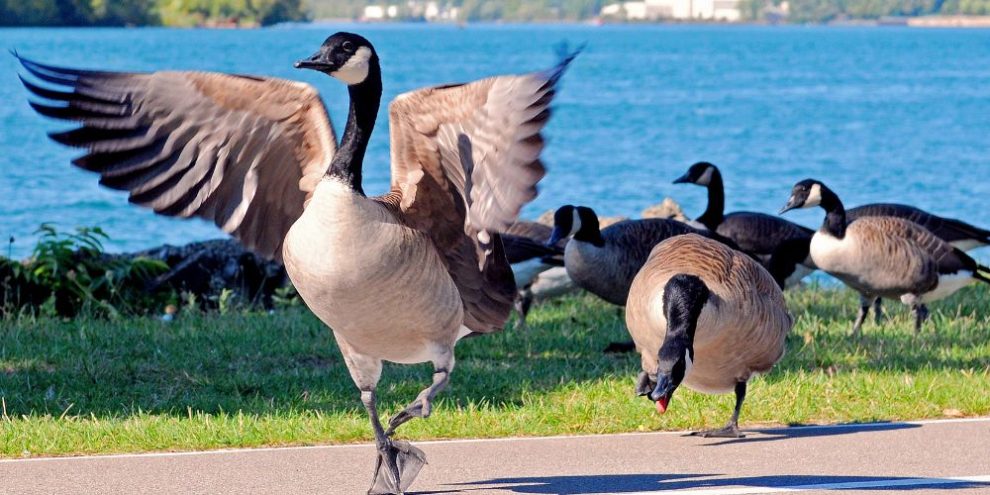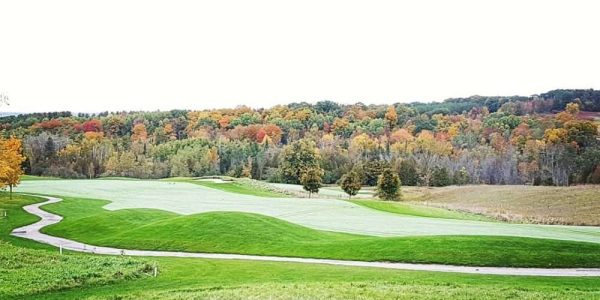
This Barrie 360 content is brought to you by Landscape Defense Systems
From their unique colouring to their flying v-formation everyone knows when they spot a Canada Goose. Not that they make their presence unknown … Canada Geese have developed a reputation for being a nuisance.
They poop constantly, honk obnoxiously and aggressively chase animals (and people) away from their territory. Not to mention they seem to be everywhere. In fact, there are more than 400,000 Geese in Ontario alone.
But the Canada Goose, often called Canadian Geese or cobra chickens to the dismay of birders everywhere, have a riveting history. One that put them at risk of extinction.
Before we dive into their past, let’s really get to know these birds.
Canada Geese 101
There are more than 400,000 breeding Geese in Ontario. Across North America, experts believe there are between 4 and 5 million in total. This is substantially more than would have occurred without human intervention. But we’ll talk about that a bit later on.
Canada Geese have an incredibly distinct look. While there’s some differences between various subspecies, they all have long black necks with white chest and chin straps. Their bodies are brown though the colour is generally lighter in eastern Canada and darker out west.
The Cackling Goose is sometimes mistaken for the Canada Goose as they have similar colouring. But the Cackling Goose has a shorter neck, stubbier bill and a rounder head.
On average, males weigh 8.6 lb but certain subspecies, like Giant Canada Geese, can weigh up to 24 lbs.
Canada Geese are primarily herbivorous, though they sometimes eat insects and small fish. They’ll also scavenge through garbage bins in urban areas.
Canada Geese are usually found near freshwater, like in streams, rivers, marshes, estuaries, and lagoons. That being said, they’re incredibly adaptable and have found it easy to live in human altered spaces. That’s why it’s not uncommon to find them on golf courses, in farmer’s fields, and at city parks.
Though the bird is native to North America, you can find Canada Geese in the UK, Sweden, Siberia, China, Japan and more.
In 1905, they were even introduced to New Zealand as a game bird.
Lifecycle Of Canada Geese
Canada Geese breed in Canada and the Northern States. In their second year, they’ll find a mate and stay together for life. If one mate dies, they may find a new one.
During their breeding season, Canada Geese molt. While molting, they lose all of their flight feathers, which means they must stick to land and water. They regain flight around the same time that their babies, which are called goslings, start to fly.
Geese will violently protect their babies from eggs to maturity by hissing, biting, and slapping with their wings. Like penguins and lions, Geese will also form creches, where multiple pairs of adults will work together to look after each other's goslings.
Canada Geese can live anywhere between 10 to 24 years.
Migration
Most Canada Geese are migratory. This means that they escape the cold every winter by flying to different parts of the world. However, some do live year round in the northern half of US and southern BC where there’s food and water year round. These Canada Geese are resident Geese.
For those that do migrate, they spend their winters in the Southern United States and Mexico.
Young Geese remain with their parents until they’ve completed one full migration and have returned to their birthplace. In late summer/early fall, families of Geese get together in large flocks.
Sometime between September and November, the Geese will take off as the climate changes and resources become scarce. Canada Geese will signal that it’s time to take off by honking loudly and pointing to the sky.
Once airborne, the flock creates a v-formation. This formation allows the Geese to conserve energy by reducing wind resistance. The lead bird works the hardest, which is why each bird takes turns being at the front.
On the way to their southern destinations, flocks will use experience and landmarks to make safe stops along the way. Their initial meeting place and these stops are referred to as staging areas.
The Geese arrive back in Canada around February or March. To the disappointment of many landowners, they tend to return to the place they originally nested.
Why We Need Canada Geese?
It may be hard to believe, but Canada Geese provide many positive benefits.
In moderation, their feces can provide nutrients to the soil. Their protective instincts can also help protect less aggressive species that are living and breeding in and around their territory. For predators who are able to break through the guard, eggs and goslings are a food source.
The most important benefits, however, are their contribution to biodiversity and pest control. They can even have economic benefits for some communities.
Biodiversity
Canada Geese pick up and disperse eggs, seeds and larvae as they make pit stops. Sometimes these undeveloped plants and animals are stuck to their feathers and get shaken off. Other times they’re deposited in new areas when the birds defecate.
This transfer of species is especially important for newly restored wetland ecosystems. It can also help combat the effects of climate change by bringing species to more viable territories in the north as everything warms up.
Biodiversity can also help improve gene pools by preventing inbreeding. This helps strengthen species, increasing their ability to thrive and survive.
Pest Control
Canada Geese can also help control pests and invasive species. While mostly herbivorous, they do eat some bugs, which can include mosquitoes, flies and their larvae. They also consume common lawn weeds. More importantly though, Geese eat algae and aquatic plants that take over underwater ecosystems.
Economic Benefits
When your parks and golf courses are overwhelmed by Canada Geese, it’s hard to believe anybody would like the birds. But for many, watching Canada Geese and other birds in their natural environments is a relaxing pastime. This can lead to increased purchases of cameras and bird watching equipment. It can even attract out-of-towners who spend on hotels, dining and more.
But bird watching is only a secondary market. The main economic benefit of Canada Geese is spending related to hunting. In 2018, Ontario’s fishing, hunting, trapping, and sport-shooting economy contributed $4.7 billion to the province’s GDP.
As we will explain later, Canada Geese are protected, however, there are hunting seasons across Canada for the bird. Canada Geese are popular among migratory game bird hunters, with more than 500,000 caught each year. Some even refer to them as the roast beef of the sky.
Why We Hate Canada Geese?
While Canada Geese may have their benefits, they’re also a nuisance. Many consider them pests thanks to their ability to wreak havoc for property owners, municipalities, farmers, and golf courses.
Here are just some of the many ways that Canada Geese negatively impact humans:
1. Excrement
In areas that are well suited for the bird, it can be nearly impossible to take a step without encountering Goose poop. It’s no surprise when you consider the fact that one Goose can produce up to 3 pounds of fecal matter a day. Some parents have even complained about the poop creating slipping risks on recreational turf where they kids play. But this inconvenience is only part of the poop issue.
Goose poop contains pathogenic protozoa, E coli and other bacteria. The Canadian Wildlife Health Cooperative says there’s no direct evidence that Goose droppings pose a danger to human health. However, there is concern from other groups that Goose poop may affect water quality. It also contributes to post rain closures of swimming areas.
Large amounts of feces in water can also lead to algae blooms. This is because Goose feces is high in nutrients that promote algae growth. Large amounts of algae, as well as increased ammonia levels, can reduce oxygen. This creates a poor environment and can impact plant, insect, and fish life underwater.
RELATED: Remember when Canada Geese took over Drake's backyard?
2. Eating Habits
Canada Geese have a huge appetite and can eat up to 4 lbs per day. This can have a huge impact on the environments they live in. On farms, they will graze on and trample crops, pastures, and seedlings. This leads to lower crop yields and can affect food sources for herds.
In some provinces outside Ontario, it can even lead to claimable damages. In Manitoba from 2015 to 2018, there were average annual compensation claims totalling more than $416,000. And that was just for crops damaged by Geese.
Canada Geese can also cause damage to lawns and gardens due to grazing and trampling. Some property owners have had their yards completely stripped of their grass.
3. Aggression
Canada Geese are protective of their nests and goslings. This can cause them to show aggression towards animals and people who enter their territory. While most injuries are minor, severe injuries can happen.
Most major injuries are the result of people trying to avoid angry Geese. This includes broken bones from falling, trauma and emotional distress. Children and pets are also at greater risk.
In addition, there are stories of Geese trying to drown predators that give chase in water - this includes dogs.
They do this by luring the predator to deep water, sometimes swimming long distances to tire their chaser. Once in deep water, the Geese stand on the predator's back or use their wings to keep the predator underwater. Others in the flock may attempt to aggressively peck the predator at the same time.
4. Traffic Hazards
Canada Geese have been known to disrupt traffic and even cause accidents when drivers attempt to swerve away from a family crossing the road.
While there’s no Canada Goose specific data in Ontario, Manitoba Public Insurance said there were 202 Goose-related insurance claims in 2016. From 2015 to 2018, there were an average of $372,528 car crash claims attributed to Canada Geese each year.
And it’s not just cars that need to worry. Flocks of Canada Geese can also create dangerous conditions for aircraft. In fact, they're the second most dangerous bird in the US for planes.
Between 1990 and 2018, 1,772 civil aircraft had accidents involving Geese. These collisions can cost upward of $100 million to repair the damage done.
5. Ecosystem Management
As mentioned earlier, Canada Geese can positively affect ecosystems by helping with diversification and pest control. But Canada Geese may also cause problems for conservation objectives.
This is because their aggression and overgrazing can negatively affect other animals and sensitive ecosystems.
How Canada Geese Nearly Went Extinct
In the 1700s, the only place you would find Canada Geese was in the extreme southwest area of Ontario and the southern prairies. These locations offered ideal habitats – open grassland with wetlands. (It wasn’t until centuries later that they were introduced to BC and the eastern provinces.)
As the non-indigenous populations increased in southern Ontario, so did the clearing of forests. The settlers wanted more open fields for growing and needed the logs to build homes. This expanded the viable territory for Canada Geese and helped them flourish.
But by the early 1900s, the Canada Goose population began to dwindle. This was due to:
- Over hunting and egg collecting
- Unrestricted harvests removing their food sources
- Industrialization, which led to habitat loss
Soon, Canada Geese had disappeared from almost all of their southern Ontario breeding ranges. The Giant Canada Goose, the most common subspecies in rural southern Ontario, was believed to be extinct until 1962 when a flock was found in Minnesota.
As a result, Canada and the US signed a treaty to protect migratory birds in 1916. The treaty is known as the 1916 Convention for the Protection of Migratory Birds in Canada and the United States. It was introduced into Canadian law as the Migratory Birds Convention Act in 1917, updated June 1994 and 2005.
The Act contains regulations to protect migratory birds, as well as their eggs and nests, from hunting, trafficking, and commercialization except under specified circumstances.
In the late 1960s/early 1970s the provincial government and local conservationists reintroduced Canada Geese to southern Ontario … but there were unforeseen consequences.
Why Canada Geese Have Come Back With A Vengeance
Restoration efforts in both Canada and the US worked. Populations of Canada Geese returned to their natural habitats. But it wasn’t solely due to legislation.
Around the same time the treaty was signed and for years to come, human changes would make the natural landscape more viable for Canada Geese.
The growth of urban centers led to the removal of predators that would target eggs and goslings. Gone were the days where Canada Geese had to protect their families from coyotes, foxes, ravens, and bears.
These areas also became ideal habitats due to the lack of hunting and increased resources. More and more safe spaces were popping up near water with plentiful grass and food sources. In later decades, many of these would be man-made, including golf courses, sport complexes and planned communities. All of these things created an ideal habitat for Geese.
People also helped boost populations by breeding the Geese on their homesteads. Once grown, they would be released into the wild, sometimes in areas where they hadn’t existed previously.
Soon, populations expanded in the Canada Goose’s natural range. Large numbers even began to show up in areas that were uncommonly home to Geese.
Today’s Canada Goose Climate
Today, populations have grown so much that Canada Geese have become pests in many areas.
Numbers have levelled off in Ontario since the mid 2000s but the current population still exceeds objectives in several parts of the country. Especially in areas like Manitoba where growth rates in 2020 saw populations doubling in 8 years.
The Canadian government has not undergone any analysis to determine whether there’s an overabundance of Geese. However, they do realize that they may need to do a proper analysis in the future as populations grow.
How To Manage Canada Geese
Canada Geese are still protected under the Migratory Birds Convention Act, which is managed by the Canadian Wildlife Service.
Under the act, it’s illegal to disturb, damage or destroy nests and eggs. You can obtain a permit from the Canadian Wildlife Service to use acceptable deterrent techniques. But you can only obtain these if the birds cause damage or danger.
This doesn’t mean that landowners are required to put up with Canada Geese. There are certain techniques that you can use to prevent these waterfowl from calling your property home without a permit.
- Don’t feed the Geese. Many people enjoy leaving food out for wildlife to enjoy. But like most animals, Geese will not abandon any place that provides easy access to food. It can also be detrimental to Geese to feed them bread and other foods outside their natural diet.
- Add barriers. Geese like open spaces with room to take off and land. Breaking up these large spaces can make your property unattractive. Consider adding fences, grids or dense plants and trees. Barriers also help to prevent molting, flightless birds from easily walking onto your property.
- Keep grass long. Canada Geese prefer young grass so the shorter your grass is the more enticing it will be. Keep your grass long, especially near the water, to deter Geese from feeding on your lawn.
- Plant different grass. There are some grasses and hays that Geese find unappetizing. Look for coarse grasses that grow in your area to use on your lawn.
- Use hazing. Scaring Geese or using hazing methods, such as scarecrows, water sprinklers that specifically target Geese or making loud noises, are effective ways to stop Geese staying put.
It’s also important to time your deterrent methods. All these methods are most effective when used as soon as the Geese arrive in late February, early March. Once Geese begin molting or laying eggs, they’re reluctant to move. Relocation during this time is possible but you must have a permit to do so.
Hunting is also an option, though there are specific hunting seasons and restrictions depending on where in Ontario you live. Those looking to hunt Canada Geese must also have the correct federal and provincial licensing for migratory birds.
At the end of the day, few would disagree that Canada Geese are a nuisance. But it is also imperative that we use the right deterrent techniques and acquire the proper permits, when needed. That way you can easily remove your Canada Goose burden while preventing the endangerment of this iconic Canadian waterfowl.













